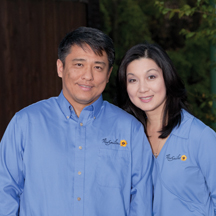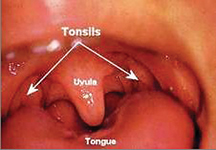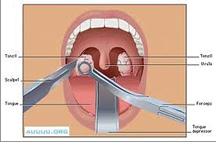Obstructive Sleep Apnea In Children. Let’s do something about it before it is too late!
 By Dr. Grace Liu and
By Dr. Grace Liu and
Dr. Lewis Yu
Obstructive Sleep Apnea (OSA) can be found in every segment of population, even in children. One distinction to be made is that OSA in adults can only be managed, not cured. However, OSA in children can be cured.
Consequence of airway obstruction is reduced oxygen available for the body. Oxygen deprivation is especially critical for the rapidly growing body and brain. Approximately 3 to 12 percent of children do snore. One to ten percent of children go on to develop various forms of sleep breathing disorder. The mild form is called Upper Airway Resistance Symptom (UARS). UARS causes brain to arouse from sleep to correct the problem then falls back to sleep again. This cycle occurs many times during the sleep; therefore, it destroys quality of sleep. Here are some symptoms often associated with UARS:
•Hypertension
•Fatigue
•Cognitive impairment
•Unrefreshing sleep
•Chronic pain (often misdiagnosed as Fibromyalgia in adults)
Some children do go on to develop full OSA.
In OSA, there are more physiological symptoms. Some of the symptoms in children include:
•Failure to thrive•Bed wetting
•Obesity
•Enlarged tonsils and adenoid tissues
•Craniofacial abnormalities
•Poor academic performance
•Gasping for air
•Unusual daytime behaviors
•Darkness under the eyes
There are many other signs and symptoms associated with OSA. The list above is, by no means, a complete list. They are mentioned to illustrate how easy it is for the physicians to be misguided to wrong diagnosis. A child with OSA symptoms can be very easily misdiagnosed as other behavior disorders such as ADHD.
The most common cause of childhood OSA is enlarged tonsils and adenoid tissues. These are soft tissues that line the upper airway and the back of the mouth. Intuitively speaking, they simply “clog the pipe”. Surgically removing these enlarged tissues has proven effective in improving airway. Numerous studies have documented improvement in snoring, OSA, frequent urination, behavior and growth following adenotonsillectomy.
Bony upper airway obstruction is the second category of causes. In this category, bony structures of the nasal/palatal physically impede airflow. Examples in this category are: deviated nasal septum, midface hypoplasia, high vault shape palate. Early intervention to correct these abnormalities, using orthodontics and surgery, would afford a child the chance of normal development; hence avoid living with airway obstruction when he or she is an adult.
Diagnosis starts with careful review of history. Unusual behavior problems are usually the first clue. Be sure to discuss with your physician and dentist about your child’s behavior pattern. If there is a definite sleep disorder pattern, the physician then can do a detailed examination of the airway. He would be looking for any soft or hard tissue blocking the airway. Should there be enough evidence from physical exam to support the OSA diagnosis, polysomnography (sleep test) is warranted to get the definitive diagnosis.
Treatment options vary greatly depending on the cause and severity.
For the most common cause of obstruction which is enlarged tonsils and adenoids, surgical removal is the first line of treatment.
When facial and palatal bone structure is the cause of constriction, orthodontic manipulation may be called for to expand the bony air passage. Childhood obesity is increasingly playing a bigger role in this disease. Healthy eating lifestyle is a prominent requirement in any
treatment plan.
Early detection and treatment for childhood OSA allows a child to have normal development both physically and behaviorally/emotionally. Treatments at early stage of the growth curve tend to have greater and more permanent effects. This represents an opportunity to unlock a child’s growth potential. Imagine how much better a happy, physically fit, socially well adjusted child will do in life, compared to a grumpy, often ill child?
Your dentist is in a unique position to help in detect and treat airway issues. We see your children more often than your medical doctor. We get to know your kids intimately. This makes us great as the first line in detection. So, talk to your dentist about your child’s snoring. It may change his life.
All About Smiles, PA. offers comprehensive general and cosmetic dental services, such as veneers, crowns, bridges, implants, whitening, as well as, Invisalign®. The practice also provides comprehensive neuromuscular(TMD) evaluations and treatment
and smile makeovers.
Dr. Lewis Yu earned his dental degree from the University of Pennsylvania School of Dentistry in 1996. He received two years of advanced post-graduate oral surgery training in both the New York City Hospital System and the Hospital of the University of Pennsylvania. He continues his education through extensive hands-on training at the prestigious Las Vegas Institute for Advanced Studies and the Pankey Institute. The Las Vegas Institute has provided Dr. Yu with advanced training in Neuromuscular Dentistry and Comprehensive Aesthetic Restorations. He had practiced in Philadelphia and Newark, DE before joining All About Smiles, P.A. He is a member of the Delaware State Dental Society, American Dental Association, and the Academy of General Dentistry.
Dr. Grace Liu has been practicing dentistry since 1996, having earned her degree from the New York University School of Dentistry. She continued her education through post-graduate studies at Columbia University, the Las Vegas Institute for Advanced Studies in Nevada and the Academy of Dentistry. She is also a member of the Delaware State Dental Society, American Dental Association, and the Academy of General Dentistry.





